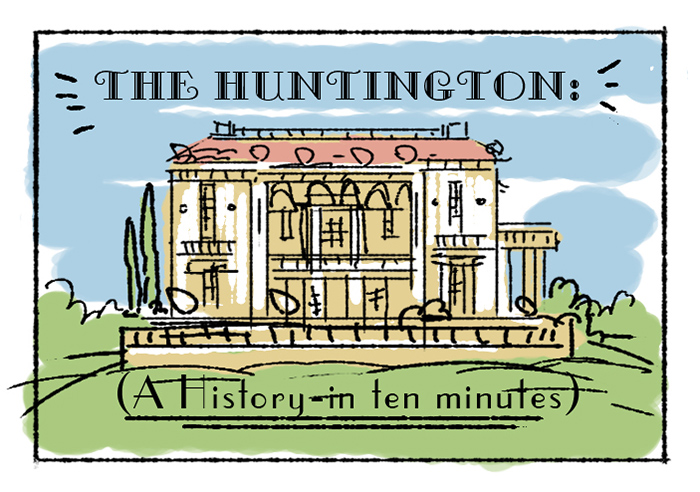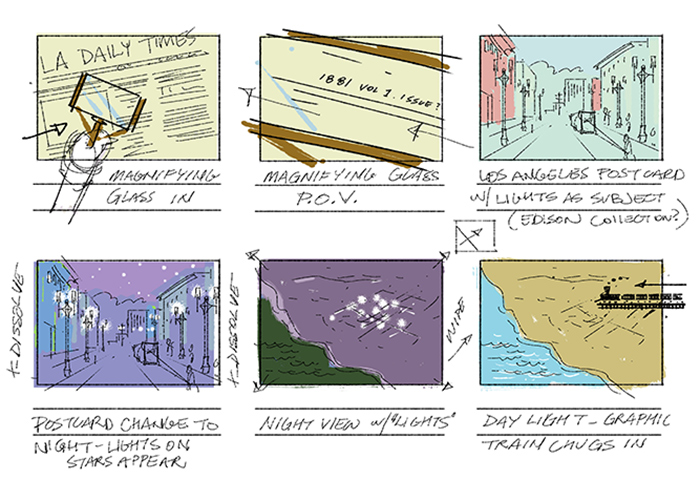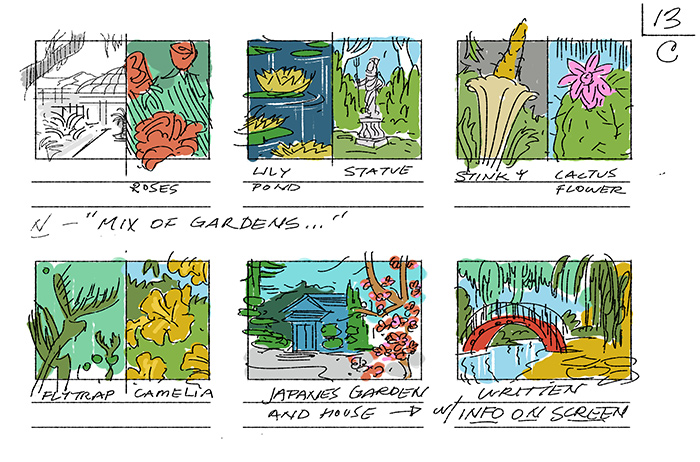The Huntington’s blog takes you behind the scenes for a scholarly view of the collections.
Animated History
Posted on Tue., Aug. 11, 2015 by

The title frame from the storyboard that director Cosmo Segurson created for the film The Huntington: A History in Ten Minutes.
Next time you’re in the Mapel Orientation Gallery, take 10 minutes to watch a delightful new film about the history of The Huntington. Designed and directed by Los Angeles–based filmmaker and animator Cosmo Segurson, it tells the story of Henry and Arabella Huntington and how the institution they created came to be. The film presents visitors with a visual smorgasbord that includes animation, live action, and still images from The Huntington’s collections.
Since graduating from film school at California Institute of the Arts in 1996, Segurson has been making short films and working in the animation industry. He says that being a storyboard artist by trade helps him resolve complex technical questions before spending the time, money, or energy on a film production.

This section of the storyboard evokes Henry Huntington’s first visit to Southern California in 1892. An animated train engine chugs across a map of the region in the final frame.
“I use storyboards to communicate with everyone involved with the production,” says Segurson. “I use them to plan my compositions or to provide a jumping off point for designers, cinematographers, actors, and even musicians.” Segurson’s artistry turns once-still photographs into active, clever animations that bring history alive.
The film evokes Henry Huntington’s first visit to Southern California in the spring of 1892. An animated train engine chugs merrily across a map of the region. Archival images give us glimpses of the working ranch in San Marino with its majestic oak groves that Huntington would purchase in 1903. We also observe a rapidly developing Los Angeles. The film incorporates dynamic splashes of color in both the animations and photography.
“Most of the images are from the archives at The Huntington,” says Segurson. “I manipulated them, turning to photography and printing techniques from the Gilded Age for inspiration. Magic lantern slides and penny postcards often used hand-colored printing techniques that I emulated in the film.”

An image of Arabella Huntington moving across a dark globe represents her frequent transatlantic journeys to Europe.
The photographs are originals, but the animation makes them pop. Black-and-white animated scenes of industrial cogs and gears highlight the story of the development of railroads. Clever high-contrast animations illustrate the rise of philanthropy among the nation’s wealthiest citizens in the early 20th century. We see a striking image of Arabella Huntington moving across a dark globe to represent the frequent journeys she took to Europe after the death of her first husband, Collis P. Huntington (Henry’s uncle). “I love that photo of Arabella in head-to-toe black mourning attire,” says Segurson.
The film’s music comes from the Huntingtons’ era and includes compositions by Debussy and Saint-Saëns in honor of Arabella’s penchant for all things French. A marching-band version of “I Love You, California,” composed in 1913, plays throughout the tale of Henry’s railroad successes.
Objects from the Huntingtons’ personal collections flash across the screen, providing insight into their Gilded Age lifestyle, and we learn how they designated their estate as a research and educational institution in 1919. The final minutes of the film bring us up to date on The Huntington’s history. The result is a wonderfully immersive experience. Don’t miss it.
If you can’t wait to see the film in the Mapel Orientation Gallery, then check it out now on Vimeo or YouTube.
To see more of Cosmo Segurson’s work, visit his website.
Related content on Verso:
A Window into The Huntington (July 24, 2015)
Quirky Tours (July 7, 2015)
Taking the Long View (May 19, 2015)
Let’s Get Oriented (Apr. 3, 2015)
Olivia Hummer is an intern in the office of communications and marketing at The Huntington.
